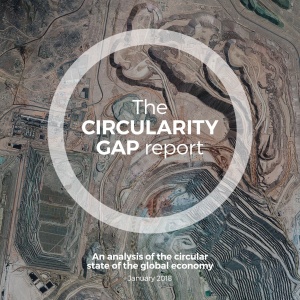
A report by the social enterprise Circle Economy finds that today’s economy is only 9.1% circular, based on their newly launched Global Circularity Metric. To move away from the current linear economic model, the report recommends extracting fewer resources, wasting less, optimising the resources we already have and cycling more resources back into the economy.
Resource extraction has increased 12-fold since 1900, putting pressure on the environment. The report defines a circular economy as one that reduces raw material extraction, cycles waste streams back into valuable products and decouples desirable social outcomes from resource use.
Of the 92.8 Gt of materials entering the economy in 2015, only 8.4 Gt came from recycled waste streams (shown in the figure below). From this comes the Global Circularity Metric (GCM): 9.1% of material entering the economy has been cycled in 2015. The GCM is limited by the availability of data (particularly on discarded materials), does not account for the quality of cycled materials and does not necessarily reflect the presence of ‘circular’ strategies in the economy. Nevertheless, the GCM indicates a large gap between the present economic system and the desired circular system.

The report points out that a fully circular economy may not be practical, because emerging economies are still building up their material stocks, stocks of rare materials such as rare earth materials are still being built, we don’t yet have the technological ability to fully recycle all material and some materials are sufficiently abundant on the planet that it does not necessarily do major damage to extract them.
The report sets out seven principles for moving towards a more circular economy:
- Prioritise regenerative resources
- Use waste as a resource
- Preserve and extend what’s already made
- Rethink the business model
- Design for the future
- Incorporate digital technology
- Collaborate to create joint value
To put these principles into action, the authors recommend building a global coalition to track progress, working with all stakeholders to develop a global action plan, translating targets into local actions and improving understanding of how circular economy principles can affect areas such as trade, climate action and future generations.
Read the full report here. See also the Foodsource chapter Food systems & contributions to other environmental problems.












Post a new comment »